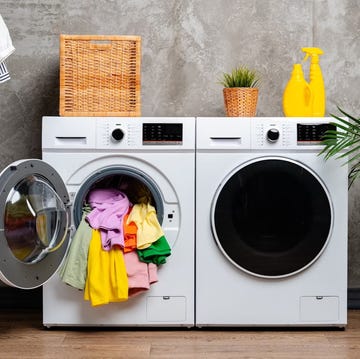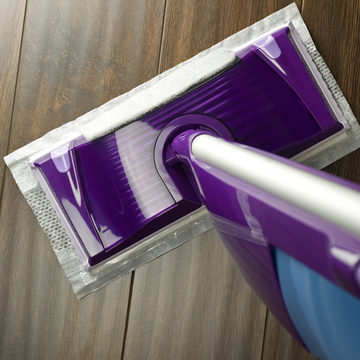If you own a home, you know how much goes into maintaining it. No one gets to every last item on the to-do list. (Seriously, who lubricates their door locks and hinges once a year, the way manufacturers recommend?)
We get it: home maintenance can be a little tedious. But there are some upkeeps that you absolutely must stay on top of, since skipping them could lead to catastrophe, including fires, floods, mold and more. Our experts in the Home Improvement & Outdoor Lab at the Good Housekeeping Institute pulled together this essential to-do list, aimed at keeping your home and everyone in it safe throughout the year.
Clear the dryer vent.
Of the nearly 3,000 home dryer fires that are reported to fire departments each year, the leading cause is inadequate cleaning, since it allows the buildup of combustible lint inside the machine. Cleaning the lint screen on a regular basis is important, but at least once a year you also need to clear the vent.
Start by turning off the power to the dryer at your home’s electrical panel. To access the vent, you'll probably need to pull the machine away from the wall. Separate the vent from the dryer, then use the crevice tool on your vacuum to suck up lint and other debris from both ends of the duct.
Our cleaning experts are fans of the Hurricane Lint Lizard, which saves you from having to move the dryer. Instead, simply attach the plastic contraption to the end of your vacuum, insert it into the dryer through the lint screen compartment, and it will suck lint from deep inside the vent.
Insulate water pipes.
A single burst pipe in your home can cause upwards of $5,000 in damage, according to the Insurance Information Institute. Many homeowners think frozen pipes only happen in cold parts of the country, but the truth is they’re a bigger threat in mild regions. That’s because pipes in these areas tend not to be insulated, making them susceptible to freezing and bursting during unexpected cold snaps.
Pipes in unheated spaces like basements, attics and garages are vulnerable, as are water lines that run through cabinets or exterior walls. Wrap these pipes in foam insulation sleeves, available at home centers and plumbing supply stores for less than $1 per linear foot.
Check smoke alarms.
Roughly three out of five fire deaths happen in homes with either no smoke alarms or none that are working, according to the National Fire Protection Agency. For maximum protection, alarms should be placed inside each bedroom, outside each sleeping area and on every level of the home, including the basement. Once a month, make sure the alarms are working by pressing the test button.
Carbon monoxide is another danger that claims about 400 lives every year in the U.S. Known as "the silent killer," it’s an odorless gas that can escape from faulty gas-fired equipment, like clothes dryers and water heaters.
Our experts recommend combination smoke and carbon monoxide detectors that protect against both threats. Most of the devices are interconnected, meaning you’ll be alerted to danger in one part of the house when you’re in another.
Keep gutters clean.
Clogged gutters lead to a host of problems, including leaky roofs, damaged foundation walls and mold outbreaks. Climbing up on the roof is dangerous work, so this is a good project to hire out, at an average cost of around $150.
If you decide to clean the gutters yourself, make sure your ladder is on firm, level ground and at a safe angle from the house. Wearing work gloves, scoop out leaves, pine needles, and any other muck that’s preventing rainwater from reaching the downspout. Then spray water from a garden hose to remove smaller debris, and to check that water is draining freely through the downspout to the ground below.
Our experts say that installing gutters guards is a great way to prevent clogs from occurring in the first place. In our tests, micro-mesh screens were excellent at keeping debris out of the gutter while withstanding even the heaviest of rainfall.
Sweep the chimney.
If your wood-burning fireplace gets a lot of action in the winter, a smoke residue called creosote will start to form on the chimney walls. Left unchecked, it can block the flow of smoke up the chimney, and even release carbon monoxide back into the home.
Sweeping the chimney is not a DIY project, since it involves a lot of specialized equipment, like cameras and long wire brushes. The website of the Chimney Safety Institute of America (CSIA) lets you search its online directory of some 2,000 members by zip code. The service will likely cost around $250.
Chimney sweeps get busy during the winter, when fireplace issues arise the most. So take advantage of their downtime by scheduling your tune up during the summer or early fall.
Having written thousands of product reviews and how-to articles on all aspects of home ownership, from routine maintenance to major renovations, Dan (he/him) brings more than 20 years of industry experience to his role as the director of the Home Improvement & Outdoor Lab at the Good Housekeeping Institute. A one-time roofer and a serial remodeler, Dan can often be found keeping house at his restored Brooklyn brownstone, where he lives with his wife and kids.
















